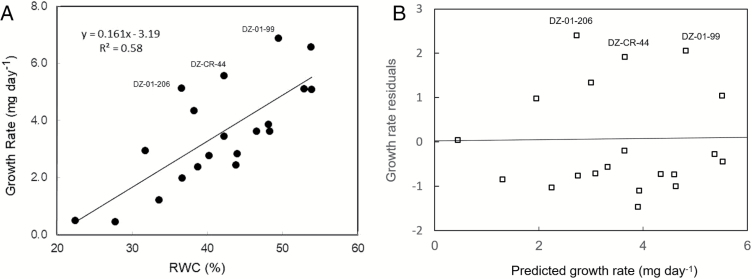Fig. 1.
(A) Linear regression of recovery growth (i.e. growth rate after recovery irrigation) on RWC at peak stress (before recovery irrigation) in 20 tef (Eragrostis tef) cultivars at the juvenile growth stage. Plants were grown in pots under 18/25 °C night/day temperatures and 480 µmol m−2 s−1 of photosynthetically active radiation, and irrigated with half-strength Hoagland’s nutrient solution. Irrigation was terminated at 25 days after emergence. Recovery irrigation was applied at 33 days after emergence, when most leaves were wilted or desiccated. Just before recovery irrigation, plants were sampled for their total shoot dry weight and the RWC of the “pseudo-stem”, which consisted of the basal leaf sheaths enfolding the growing meristem. Ten days after recovery irrigation, a second sample of plants was taken for determination of total shoot dry matter for the calculation of daily plant growth rate (Blum 1998, unpublished data). (B) Deviation of tef genotypes from the regression of cultivar recovery growth rate on RWC (shown in A) presented as studentized residuals [the growth rate residuals (outliers of the regression) divided by an estimate of their standard deviation (Pope, 1976)] of actual growth rate compared with the predicted growth rate according to the regression. The three genotypes labeled are those with the most positive deviation.

